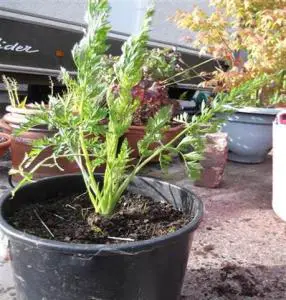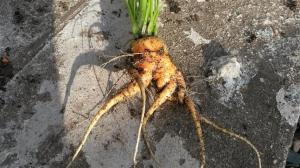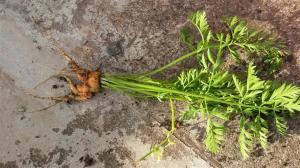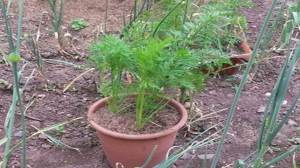Never Transplant carrots!
If ever there was any doubt as to the wisdom of transplanting carrot seedlings, then the following pictures should put these doubts to rest 🙂
I transplanted some seedlings from a shallow tray that my wife had scattered a packet of seeds in (Yea I would blame the wife!), into a variety of pots and containers – and the results you could say are predictable.
Though I must say that as they grew, they looked to be in ‘rude health’ with great foliage showing no signs of the disaster unraveling beneath the soil. Strong green leaves, with no signs of the dreaded carrot fly (which causes the leaves to droop as the plant expires). The containers were kept moist yet free-draining, a condition that suits carrots just fine – as you might see from the picture.
The soil mix was good, with a good mix of sand for drainage and home-made compost mixed with peat for the nutrients and friability of the growing medium.
mixed with peat for the nutrients and friability of the growing medium.
All was looking good. Maybe, just maybe I though, they would grow to be healthy carrots despite my reservations. Alas it was not to be- though we did have a good laugh at the results it has to be said 🙂
Believe it or not my wife insisted that we eat them anyway, and spent ages cleaning them with a toothbrush!
The big surprise is that they tasted delicious – sweet and crunchy, hmmm
Wy did the carrots go mis-shaped?
There are a couple of things that can cause your carrots to come out this way, one of them is as previously described. Another is stones and other obstacles in the soil. Yet another is a disease called club root which attacks the root of the plant and affects the root and the foliage.
This was not the cause in this instance, the answer is much simpler. When you transplant carrot seedlings it is almost always doomed to failure for 1 main reason (there are others), the root becomes twisted as you insert it into the ground. This does not straighten out, but rather the problem is exacerbated as the carrot grows.
As you can see from the pictures, this does not stop the carrot from growing and looking great on the surface – underground however it is different matter!
It is not impossible to transplant carrots with some success, but it is very difficult even if you choose the right growing medium and have no obstacles in the way (the usual cause of carrot deformity such as we see here).
The Right Way To Grow Carrots:
If you want to follow the proper guide for growing straight carrots, then sow them in a traditional manner (from seed) – in a container that is deep enough to let them grow. When it comes to thinning-out, simply trim the extra carrots just below the surface with scissors, leaving about 2 inches between the plants.
By trimming the carrots in this way you will minimalise soil disturbance and help prevent the dreaded carrot fly from making an appearance. Get full instructions for growing your carrots on this page.
Do Parsnips get carrot fly damage?
Transplanted Parsnips are prone to twisting just as carrots are, so they need very much the same care as carrots when planting them out. The bad thing about parsnips though is that they are prone to the carrot fly as is celery, celeriac, and parsley so all the precautions and tips to grow parsnips are very much the same as for carrots.
Growing carrots and parsnips in straw bales is also a good way to help minimalise damage from other insects and slugs.
Summary:
Finally, the best and most productive way I find to grow straight carrots or parsnips, is in a Raised Bed situation. With this no-dig gardening technique you are more in control of the growing environment, and can choose to fill the Bed with a good sandy mix that enables carrots to grow exceptionally well.






